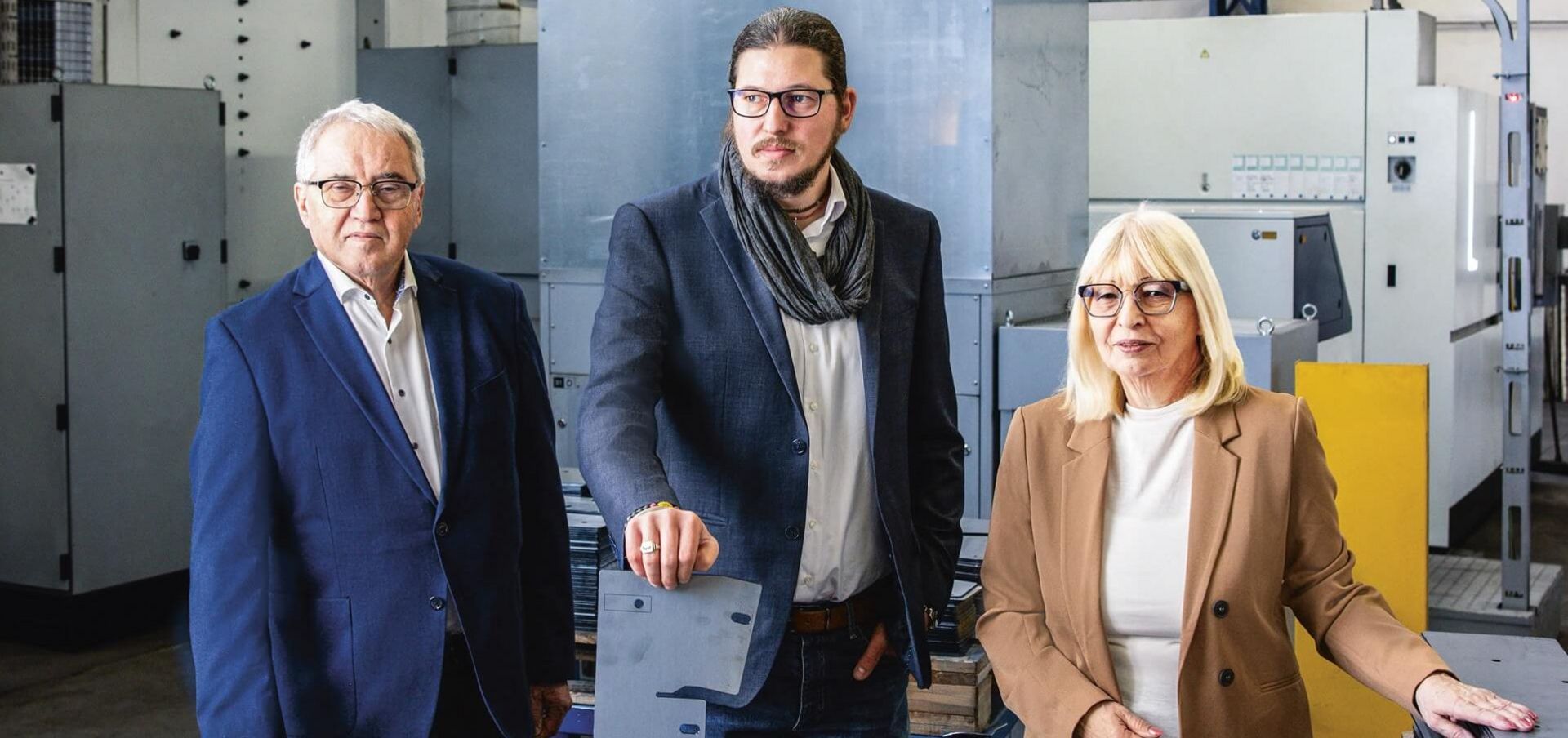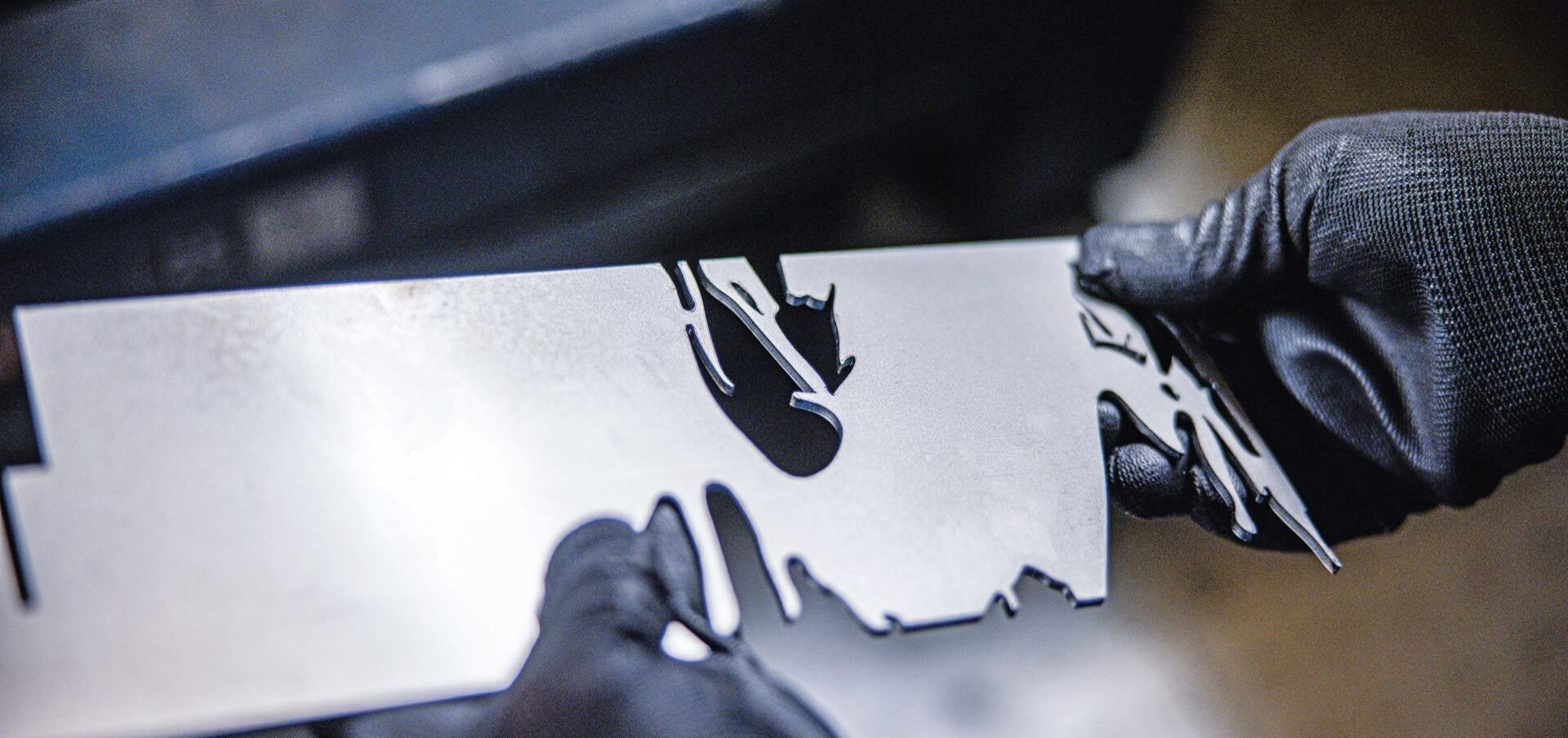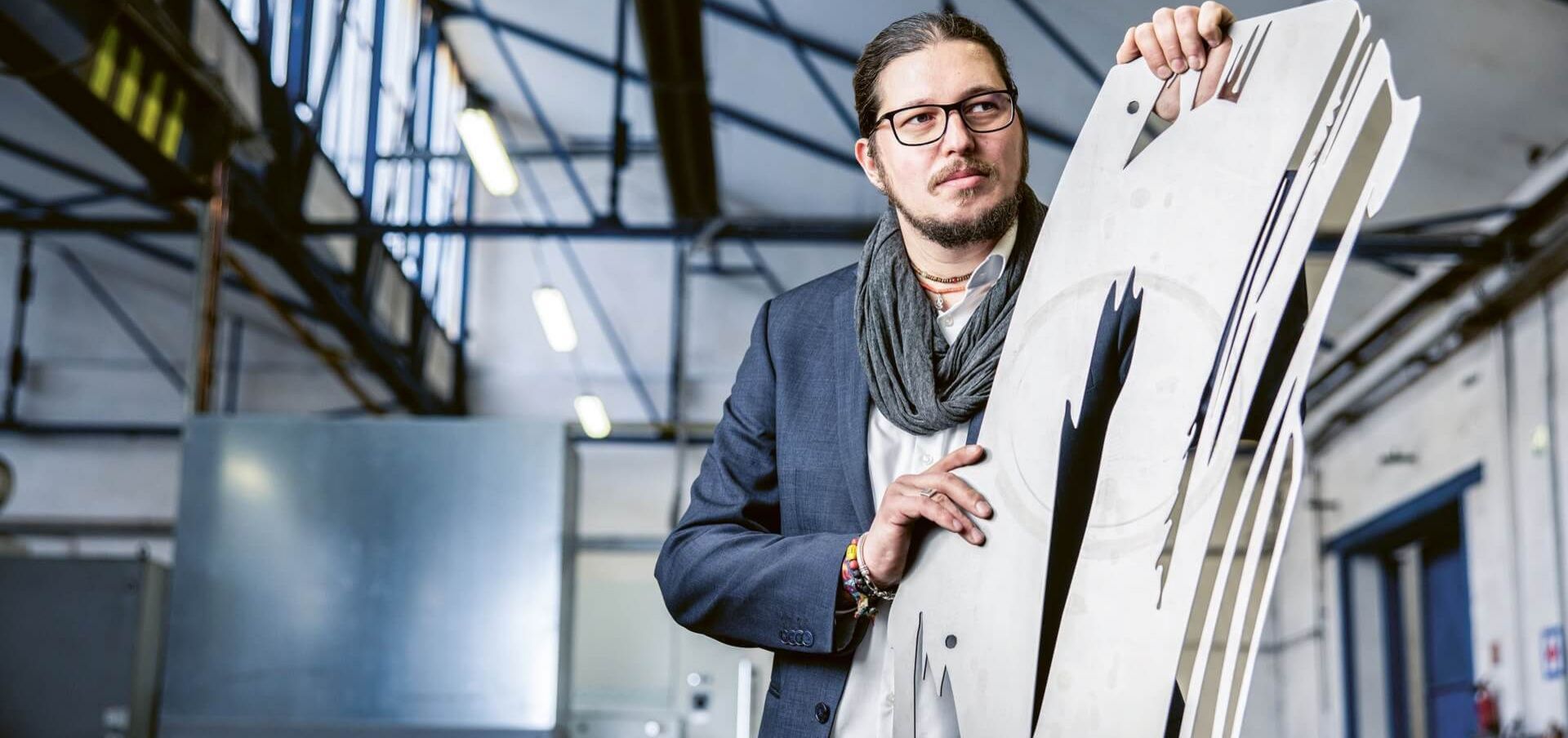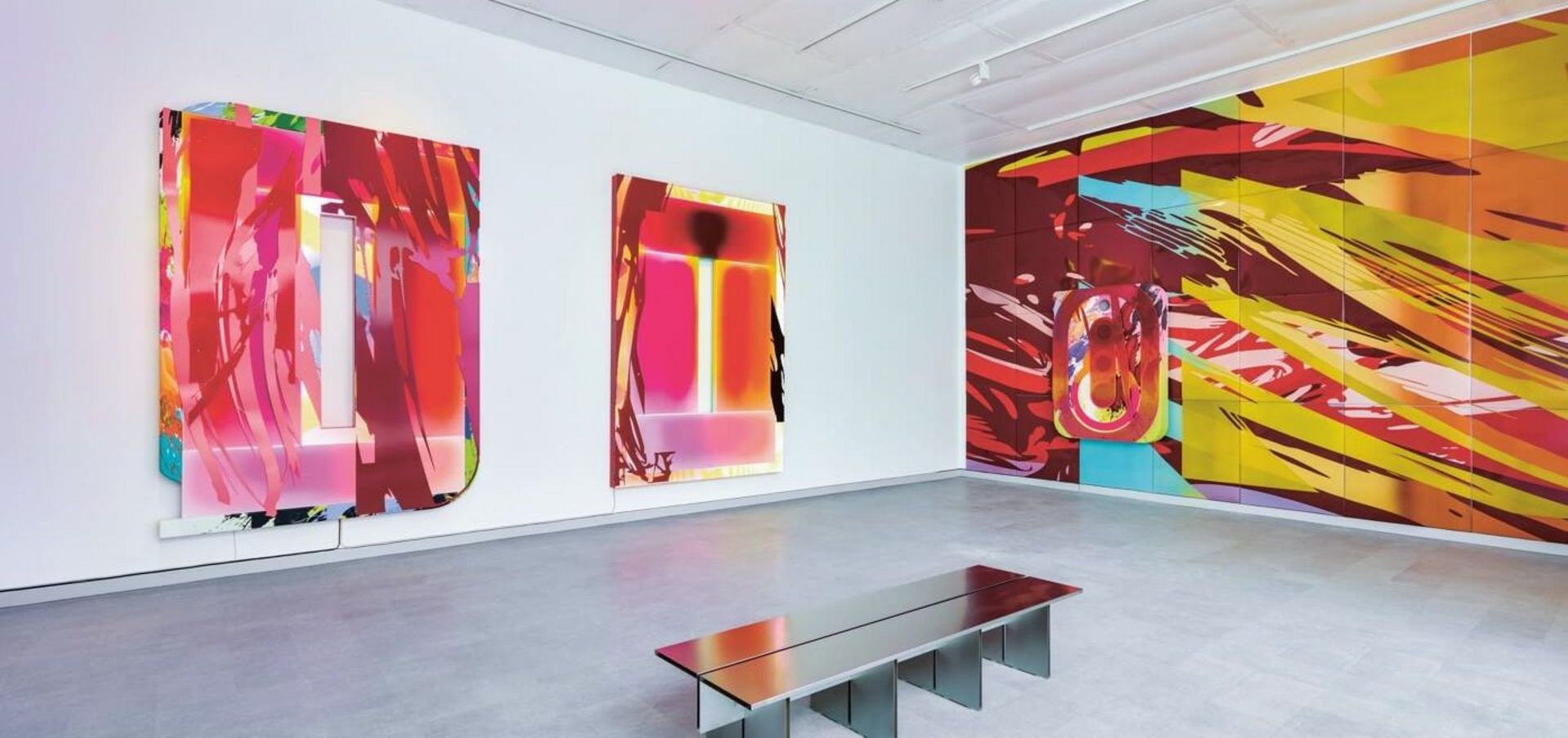The art of laser-cutting: Set against a silhouette of a forest crafted from precision-cut sheet metal, illuminated shapes drift through thousands of LEDs to the rhythm of a meditative soundscape. As they move, they pulse in time to the music of double bass vibrations, gong reverberations, and the ethereal tones of Tibetan singing bowls. Hungarian artist Márton Nemes spent two years planning and producing this multisensory experience for his Techno Zen installation, which was hosted by the Hungarian pavilion at the 2024 Venice Biennale, the world’s largest exhibition of contemporary art. His vision was transformed into reality by a small Hungarian family business called Intertechnika, which cut and bent many of the abstract shapes using TRUMPF technology.
From heavy industry hub to artistic haven
Many of the installation’s paintings and sculptures were crafted in Budapest’s Csepel district. From 1892 to 1993, this island on the Danube was a hub of heavy industry, home to manufacturers of motorcycles, cars and commercial vehicles. Today, one of these historic industrial buildings serves as Intertechnika’s headquarters. “We’re a small company focused on contract manufacturing,” says Peter Alasztics. “We process around 28,000 drawings a year to produce everything from transformer components to housings for Siemens.”
But that’s only part of the story. In the past two decades, Intertechnika’s team of 64 employees has also become highly skilled at creating bespoke products. Using TRUMPF machines, the company cuts, bends and shapes sheet metal for artists from all over Hungary, and its team of designers has built a reputation for pushing the boundaries of what’s possible. “We enjoy tackling complex projects,” says Peter Alasztics.

Peter and his brother Márton are the second generation to head up the family business. Their parents, Jullianna Alaszticsné Kovács and Béla Alasztics, founded Intertechnika in 1991 during the chaotic period following the dissolution of the Soviet Union. Initially focused on building and maintaining CNC machine tools, they soon realized that the demand for such technology was declining. By 1999, they had relocated to their historic industrial building on Csepel Island. In 2000, they acquired their first laser – a second-hand 1.5 kW cutting system – and shifted their focus to sheet metal processing.
Taking Hungarian technology to the next level
“Back then, laser technology and sheet metal processing were still relatively new in Hungary,” recalls founder Béla Alasztics. “For us, it was an opportunity to get an early foothold in an emerging technology.” They learned the ropes with the help of a friend who was already using lasers to produce machine tools. In the early 2000s, Intertechnika began collaborating with TRUMPF, acquiring its first TRUMPF machine, a TruMatic L 4030, in 2002. The company quickly embraced innovative technologies such as automated laser cutting systems. “As TRUMPF introduced new processes, we were often among the first companies in Hungary to try them out,” says Béla Alasztics. “And TRUMPF was always on hand to help us put its innovative approaches into practice.”
However, working within Csepel’s historic industrial buildings came with its own set of challenges. While Intertechnika has room to expand within its facility on the Danube island, structural modifications are prohibited due to its protected status. “When we installed our first laser cutting machine, it came to within 20 centimeters of the roof!” Peter explains. “But TRUMPF helped us make the best use of the existing layout.” The Ditzingen-based company continues to support Intertechnika today, helping it reach new heights. “That first laser from TRUMPF opened the door to a whole new world of possibilities,” says Peter.
In 2005, Peter introduced art into Intertechnika’s business – an idea that initially met with skepticism from his parents, recalls Béla. While studying at Visart Art School in Budapest, Peter met István Ézsiás, an artist now in his eighties, who was intrigued by the scrap metal generated by Intertechnika’s production processes. This encounter sparked a collaboration and led Peter to wonder how the company’s machinery could be repurposed to craft artistic objects. “Finding a common language between artists and engineers was a unique challenge,” recalls Béla. “Artists are free thinkers; they rarely consider the physical properties or limitations of materials,” adds Peter. “Engineers have almost the exact opposite mindset.”
While his brother Márton focused on business administration, Peter pursued graphic design, culminating in a Master’s thesis at Berlin University of the Arts that explored the collaboration between engineers and artists. Working alongside Intertechnika’s design team, he gradually learned to interpret artists’ creative visions and put them into practice.

Learning from artists
Since 2017, Hungarian artist Márton Nemes has collaborated closely with Intertechnika, starting with a project that required the company to cut a specially coated, rainbow-colored sheet metal – an exceptionally unusual and expensive material that only Intertechnika was willing to tackle. “We had never encountered anything like it before – and haven’t since,” recalls Peter.
Despite the challenge, the project was a success, and Nemes continues to feature the resulting pieces in many of his solo exhibitions. “I had no idea such technology existed until that moment,” says Nemes. “It completely transformed how I approach my sculptures.” Today, nearly all his sculptures are developed in close partnership with Intertechnika. “Before we started working together, I used entirely different materials,” Nemes explains. “The combination of sheet metal and lasers has opened up a whole new world of creative possibilities.”
Intertechnika is now a cornerstone of Hungary’s art scene. Each year, students from local art universities partner with the company to create their final projects. Peter Alasztics actively encourages his nine-member design team to push boundaries and experiment, knowing that the skills they learn from creating one-of-a-kind artworks often feed back into their production work. For instance, techniques refined through art collaborations have been adapted to produce durable, impact-resistant tablet housings for prison inmates as well as intricate lamp casings for Budapest’s iconic Széchenyi Chain Bridge.
The two brothers are now planning to increase automation within Intertechnika’s production processes, driven by the recent introduction of TRUMPF’s Oseon software. This is yet another step forward in the family tradition of embracing cutting-edge technology and innovative software solutions. The hope is that Oseon will make it more efficient and cost-effective to manufacture their standard products, freeing up valuable resources for the creation of bespoke artistic pieces. “Innovation means always seeking to create something new,” says Peter Alasztics. “Whenever one of us thinks a project is too complex to handle, we look at the art we’ve helped produce and remind ourselves just how much is possible!”














